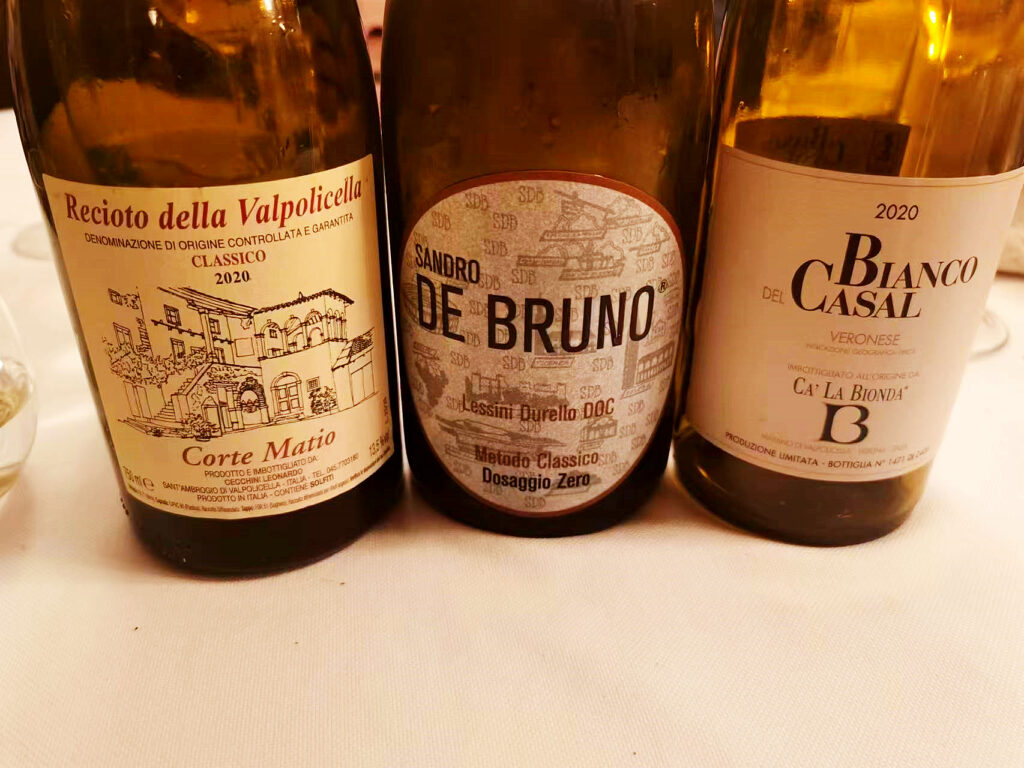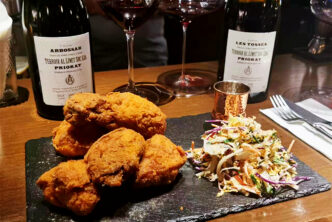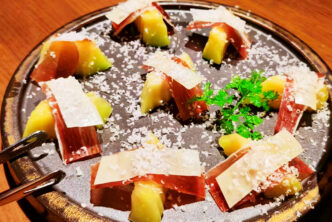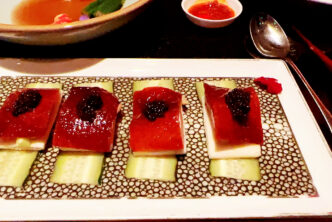Ristorante Groto de Corgnan
Via Corgnan, 41
37015 Sant’Ambrogio della Valpolicella (VR)
Italy
Tel. +39 0457731372
Tel (English): +39 3457766004

The dishes
Gnocchi di patate fatti in casa con sugo di cervo e salsa di mirtilli
Tortelli fatti in casa di faraona alla cacciatore con salsa di faraona e funghi
Petto d’anatra con cipolla e uvette cotte in Recioto bianco
Cinghiale della Lessinia all’Amarone con polenta macinata a pietra e radecela
Gelato alla crème con castagne cotte nel miele
Some restaurants punch way above their weight class, and that is precisely the case with the Groto de Corgnan. This small restaurant, tucked away in a hamlet in the heart of the classic Valpolicella production zone, is not named after grottos or caverns, but rather after a small stream (groto, in local dialect) and the street the restaurant is located on (via Corgnan). This lovely, quaint dining spot (with a comfy outside dining area) offers a very solid traditional Veneto cuisine, outstanding, truly friendly, caring service (the type we are really all no longer used to) and a reasonably good wine list (about 200 choices or so) where you can find -logically enough- many a white or red from the Valpolicella denomination but also real jewels such as a long list of excellent Barbaresco and Barolos as well as jewels from many other Italian viticultural areas, such as for example the lovely, harder to find Valle d’Aosta wines of Les Crêtes. In short, though the choices are not endless, there is something for everyone, including an adequate selection of good bubblies (about ten different labels from both France and Italy). Furthermore, a good selection of distilled spirits awaits at dinner’s end (including some artisanally-made flavoured grappas that are wheeled out on a trolley to your table). The dishes are very well-rendered and thoroughly enjoyable: not all are as concentrated or complex or as spicy in their aroma and flavour profile as one might wish for, but I guarantee you will come away from your dining experience at the Groto totally satiated and happy, which is more than I can say for many Italian one- and two- Michelin star restaurants that turn out to be, more often than not, frankly disappointing (see future, upcoming, Restaurant & Wine Reviews columns in TerroirSense Wine Review for the skinny on this subject). And the cost of your fine dining meal here will be that of a song, further making the dining experience recommendable and worthwhile.

The Groto de Corgnan has a curious, interesting history. It’s been in business since 1980, and at least thirty-five of those years saw the stewardship of chef/owner Giorgio Soave and his wife Assunt. The pair encountered success after success (as an example, suffice to say that the little restaurant has been listed continuously in the Michelin guide since 1981 and has garnered many awards and honourable mentions in its time). Today’s version of the Groto is quite a bit removed from the original in terms of ownership, if not in that of food and wine (which, as mentioned previously, remain lovingly traditional). In fact, the current owner is much-travelled Judy Harman, an Australian lady who speaks Italian well and clearly is very attached to her restaurant: and why would it not be so, given that she used to be a regular client of the place and fell so in love with it that she ended up taking it over when Soave decided to retire. In one of the many curve balls that life throws at you, while dining at the restaurant one day in 2015 (and where she had been dining regularly since 1999), Soave told her that he had decided to close the restaurant for it was time for him to hang up his pots and pans. Harman would have none of it: she decided to take over, even going as far as relocating with her husband from Sydney, where she was living at the time. The Groto for her was and is a true labour of love, one for which she was schooled for two years in the region’s and the restaurant’s culinary creations by the outgoing chef and owner (a specific request of hers at the time of sale, for Harman wanted to ensure she would be able to carry on the Groto’s tradition in a manner worthy of the storied little place). The menu changes seasonally and continues to features locally sourced farm products from both the Valpolicella and nearby Lessinia areas woven into the fabric of Soave’s and the region’s long-standing recipes. (With the arrival of young chef Riccardo Pighi in 2018, the recipes were somewhat updated and freshened up, but remain essentially faithful to the originals.) The Groto is open for dinner Monday through Sunday (save for Wednesday, day of rest) and for lunch too on the two weekend days.

Roughly two-three weeks ago, I dined with two friends at the Groto and were left more than happy with the experience. The gnocchi di patate fatti in casa con sugo di cervo e salsa di mirtilli was hearty comfort food at its best: I personally would have liked a more discernible blueberry flavour, that was slightly camouflaged in the sauce’s other ingredients, but to be clear, I’d order this dish again in a heartbeat, as it really was that satisfying. To my chagrin, the tortelli fatti in casa di faraona alla cacciatora con salsa di faraona e funghi proved even more satisfying (I write this tongue in cheek as deer and blueberry sauce is one of my three favourite pasta sauces): the pasta of the tortelli was thin and flavourful, and the filling spot on, like the sauce. Splendid. For those who like sweet and sour touches in their food, the petto d’anatra con cipolla e uvette cotte in Recioto bianco was just what the doctor ordered, with a pleasant sweet zing from the combination of onions, raisins and Recioto (it won’t escape savvy, well-travelled diners or expert home cooks that duck is often if not almost always paired with sauces veering towards the sweet spectrum of things, and so it is in this classic Veneto rendition). With the cinghiale della Lessinia all’Amarone con polenta macinata a pietra e radecela, the meal returned to the hearty and comforting, and there was absolutely nothing to do but lap it all up and enjoy. And while the cheese selection proved as good as one might expect it to be at a place such as the Groto, the real winner at closing out the dinner proved to be the gelato alla crème con castagne cotte nel miele (yes, that’s not a typo, the menu really does read crème, not crema, as it would in modern-day Italian), a frankly quite sweet concoction (the honey-cooked chestnuts on top of the already sweet vanilla cream gelato make for a powerful one-two sugar whammy) but all those with a serious sweet tooth (such as myself) will not be able to get enough of it, loving every single spoonful of this particularly good dessert.
The wines
Sandro De Bruno Lessini Durello Metodo Classico Dosaggio Zero 90
Ca’ La Bionda 2020 Bianco del Casal Veronese 90
Corte Matio 2020 Recioto della Valpolicella Classico 88

Our wine selections on the night proved just as enjoyable as the food: to use a baseball metaphor, no home runs, but plenty of extra base hits were scored. I have always enjoyed the wines of Lessini Durello, a classic method sparkling wine denomination of Veneto made mostly with the very high acid Durella grape (though small percentages of other white grapes are allowed). These are beautifully chiseled sparklers (Fongaro and Tonello are outstanding examples). Given that I had sampled the range of both of those wineries in days preceding our visit to the Groto, I opted for the well-regarded Sandro De Bruno Lessini Durello Metodo Classico 36 Dosaggio Zero, where the ‘36’ stands for the amount of time the wine spent on the lees. Born from 90% Durella grapes and 10% Pinot Bianco (for added creaminess) planted on volcanic soil, it offers obvious flinty and saline nuances complicating the green and mostly ripe yellow fruit aromas and flavours. An earthy undertone detracts from the wine’s overall freshness and leaves one with a chewy, almost rustic mouthfeel, but given all the Durella in the blend this is one bubbly that, though bigger than many other sparklers from this denomination, remains fresh and lively enough. Rather big in style, this is probably better suited to accompanying white meat and richer fish preparations, rather than being limited to the simpler (if no less important) role of aperitif. Also on the relatively richer and thicker side is the Ca’ La Bionda 2020 Bianco del Casal Veronese a lovely white wine from one of Valpolicella’s most talented wineries (and arguably the best, or at no worst one of the three or four best, producers of Valpolicella wines, both the simpler entry-level and Superiore versions). This white wine is made with grapes picked from seventy years old vines in the Ravazzol vineyard, and is described as a mostly Garganega and ‘Trebbiano’ blend. (Once again, for the umpteenth time, it kills me how Italian wine producers are their own worst enemies: listing the latter grape generically as ‘Trebbiano” does absolutely nothing for the wine’s image and value. Is it Trebbiano di Soave, Turbiana, Trebbiano Toscano or Trebbianella? Supplying that sort of information -provided one even knows, and given the old age of the vines it would be understandable if the winery doesn’t know- only enhances the wine’s image and value, if for no other reason that Trebbianella is a very rare local variety nobody has much vines of anymore, and the Turbiana and the Trebbiano di Soave are local grapes that have nothing to do with other Trebbiano -named varieties growing elsewhere and so speak of a local Veneto terroir. But I digress.) Last but not least, the Corte Matio 2020 Recioto della Valpolicella Classico offered a nice send-off into the coolish March Veneto evening. Rather light in style but nicely balanced and not excessively sweet, it is a Recioto wine that does not leave you feeling heavy at meal’s end, though I could certainly understand those who might pine for just a little more depth and concentration.

One last, hopefully interesting, side note. I first dined at the Groto in the early 2000s, during one of my many never-ending forays into the local wine country visiting winery after winery as I have done all my life while writing for Porthos, then Gambero Rosso (where I also took part in writing the restaurant guide), then Tanzer’s International Wine Cellar, then as Contributing Editor at Decanter, and lastly as Senior Editor at Vinous prior to taking over the Editor-in-Chief job at the TerroirSense Wine Review. I loved the wine, food and service that first time I went, and nothing has happened to change my mind since then. In fact, many producers like to dine at the Groto too. One example is Alberto Di Gresy, the owner of the famous, eponymous Barbaresco estate, who dines at the Groto regularly whenever he is in the area (and the wine list carries some of his older vintages). He is not the only more or less famous person to have dined and to continue dining at the restaurant, as it is the dining end-point of many a movie star, writer and other well-known public persona. The well-heeled and happy few should know at least a little something about good food and wine: granted, it’s not a given, but still. So take it as yet another sign, besides this highly positive review, of potentially dining good times lying ahead.

 English
English



